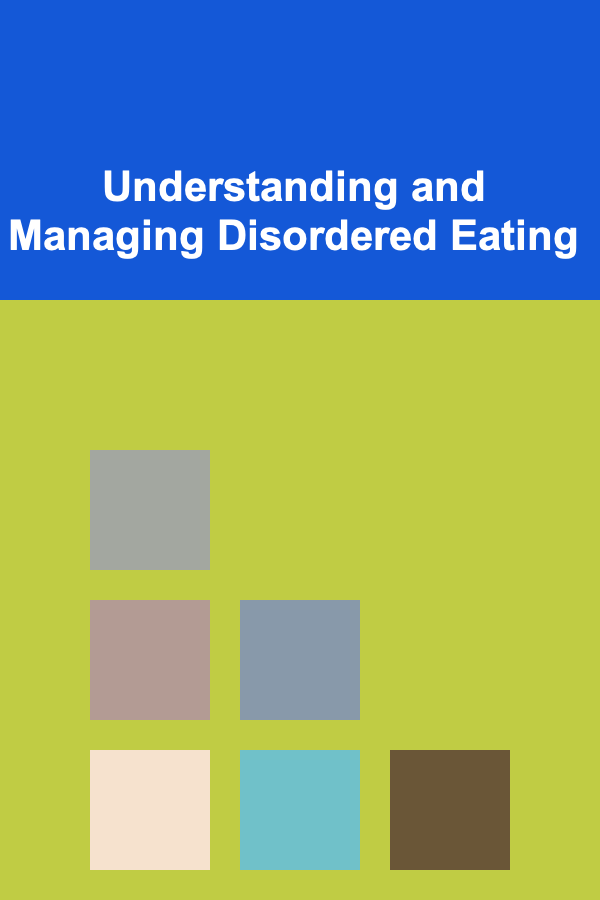
Understanding and Managing Disordered Eating
ebook include PDF & Audio bundle (Micro Guide)
$12.99$5.99
Limited Time Offer! Order within the next:

Introduction: Beyond the Diagnostic Criteria
Disordered eating is a complex and often misunderstood spectrum of behaviors and attitudes towards food, weight, and body image. Unlike clinically defined eating disorders such as anorexia nervosa, bulimia nervosa, and binge-eating disorder, disordered eating doesn't always meet the specific diagnostic criteria outlined in the DSM-5 (Diagnostic and Statistical Manual of Mental Disorders, 5th Edition). However, this doesn't diminish its significance or the potential harm it can inflict. Disordered eating encompasses a wide range of unhealthy patterns that can significantly impact an individual's physical, emotional, and social well-being. It's crucial to recognize that disordered eating behaviors can serve as a precursor to more severe eating disorders or exist independently, causing considerable distress and impairment in daily life. This article aims to provide a comprehensive understanding of disordered eating, exploring its underlying causes, various manifestations, potential consequences, and effective management strategies. We will delve into the psychological, social, and cultural factors that contribute to its development, and offer practical guidance on how to identify, address, and ultimately overcome these unhealthy patterns. The emphasis will be on fostering a healthy relationship with food, body, and self.
Defining Disordered Eating: A Spectrum of Unhealthy Behaviors
Disordered eating is characterized by irregular eating behaviors and distressing thoughts or feelings related to food, weight, and body shape. It's a nuanced concept that encompasses a wide array of behaviors, attitudes, and beliefs. Key characteristics include:
- Restrictive Dieting: This involves severely limiting food intake, cutting out entire food groups (e.g., carbohydrates, fats), or following very restrictive diets with the aim of weight loss. This can lead to nutritional deficiencies, fatigue, and an increased risk of binging. The focus is often on external rules rather than internal cues of hunger and satiety.
- Obsessive Calorie Counting: This involves meticulously tracking calorie intake and feeling anxious or guilty if a self-imposed calorie limit is exceeded. It can lead to an unhealthy preoccupation with numbers and a detachment from the enjoyment of food.
- Compulsive Exercise: This involves exercising excessively, often beyond what is necessary for health and fitness, and feeling compelled to do so even when tired, injured, or ill. Exercise becomes a means of controlling weight and shape, driven by guilt or anxiety if a workout is missed.
- Binge Eating: This involves consuming a large amount of food in a short period of time, accompanied by a sense of loss of control. Unlike binge-eating disorder, it may not occur as frequently or with the same level of distress, but it still contributes to feelings of shame and guilt.
- Purging Behaviors: This includes self-induced vomiting, misuse of laxatives or diuretics, or excessive fasting in an attempt to compensate for food intake. Even infrequent purging behaviors can be extremely harmful to physical health.
- Food Rules and Rituals: These involve rigid rules about what, when, and how food should be eaten. Examples include only eating certain foods at certain times, cutting food into small pieces, or rearranging food on the plate. These rituals can create anxiety and restrict food choices.
- Body Image Dissatisfaction: This involves having a negative perception of one's own body shape and size, leading to feelings of self-consciousness, anxiety, and low self-esteem. This dissatisfaction is often fueled by societal pressures and media portrayals of ideal bodies.
- Emotional Eating: This involves using food to cope with emotions, such as stress, sadness, boredom, or anger. Food becomes a source of comfort or distraction, leading to overeating and feelings of guilt.
- Orthorexia: While not officially recognized as a diagnosis, orthorexia involves an obsession with "healthy" or "clean" eating to the point where it negatively impacts one's life. Individuals with orthorexia may become extremely restrictive in their food choices, leading to nutritional deficiencies and social isolation.
It's important to note that the presence of one or two of these behaviors does not necessarily indicate disordered eating. However, when these behaviors become persistent, distressing, and interfere with daily life, it is a cause for concern. The key differentiator between normal eating patterns and disordered eating is the degree of distress, obsession, and impairment experienced.
The Roots of Disordered Eating: Understanding the Contributing Factors
Disordered eating is rarely caused by a single factor. Instead, it's a complex interplay of biological, psychological, social, and cultural influences. Understanding these contributing factors is crucial for effective prevention and intervention.
- Societal Pressures and Media Influence: The media often promotes unrealistic and unattainable beauty standards, particularly for women. Constant exposure to these images can lead to body dissatisfaction and a desire to conform to these ideals through dieting and other unhealthy behaviors. Social media platforms exacerbate this issue, creating a culture of comparison and competition.
- Family Environment: Family dynamics can play a significant role in the development of disordered eating. Families that emphasize appearance, weight, or dieting can create a pressure cooker environment. Critical comments about weight or food choices, as well as a lack of emotional support, can also contribute to the problem. Conversely, families that model healthy eating habits and body acceptance can foster a positive relationship with food.
- Psychological Factors: Underlying psychological issues such as anxiety, depression, low self-esteem, perfectionism, and trauma can significantly contribute to disordered eating. Food can become a coping mechanism for managing difficult emotions or a way to exert control in other areas of life. Individuals with a history of trauma may be particularly vulnerable to disordered eating as a way to self-soothe or dissociate from painful memories.
- Biological Factors: Genetics may play a role in predisposing individuals to eating disorders. Studies suggest that certain genes may influence appetite, metabolism, and personality traits that increase the risk of developing disordered eating. However, genes are not destiny, and environmental factors play a crucial role in determining whether or not these predispositions are expressed.
- Cultural Norms: Certain cultures may place a greater emphasis on thinness or dieting than others, increasing the pressure to conform to these norms. The availability of processed foods and the prevalence of dieting trends can also contribute to disordered eating behaviors.
- Life Transitions and Stressful Events: Major life changes such as puberty, starting college, or experiencing a job loss can trigger or exacerbate disordered eating behaviors. Stressful events can also lead to emotional eating or a desire to control one's body as a way of coping with uncertainty.
- Personality Traits: Certain personality traits, such as perfectionism, obsessive-compulsiveness, and neuroticism, may increase the risk of developing disordered eating. Individuals with these traits may be more prone to setting unrealistic goals, rigidly adhering to rules, and experiencing anxiety about food and weight.
- History of Dieting: Dieting, especially restrictive dieting, is a significant risk factor for developing disordered eating. Dieting can disrupt normal hunger and satiety cues, lead to cravings and binging, and create an unhealthy preoccupation with food and weight. The "diet mentality" often fosters a cycle of restriction and deprivation, followed by overeating and guilt.
It's important to remember that these factors often interact in complex ways, making it difficult to pinpoint a single cause of disordered eating. A holistic approach that addresses the individual's unique circumstances is essential for effective treatment.
Recognizing the Signs: Identifying Disordered Eating in Yourself and Others
Identifying disordered eating can be challenging, as the behaviors and thoughts associated with it are often kept secret or rationalized. However, recognizing the warning signs is crucial for early intervention and preventing the problem from escalating. Here are some common signs to watch out for, both in yourself and in others:
- Preoccupation with Food, Weight, and Body Shape: Thinking excessively about food, calories, dieting, and body size. Spending a significant amount of time weighing oneself, measuring body parts, or comparing oneself to others.
- Frequent Dieting or Restricting Food Intake: Constantly starting new diets, eliminating entire food groups, or severely limiting calorie intake. Expressing fear of certain foods or food groups.
- Obsessive Exercise: Exercising excessively, even when tired, injured, or ill. Feeling guilty or anxious if a workout is missed. Using exercise primarily to control weight or shape.
- Binge Eating or Loss of Control Over Eating: Eating large amounts of food in a short period of time, accompanied by a sense of loss of control. Feeling ashamed or guilty after eating. Eating in secret or hiding food.
- Purging Behaviors: Engaging in self-induced vomiting, misusing laxatives or diuretics, or excessive fasting in an attempt to compensate for food intake.
- Changes in Mood or Personality: Experiencing increased anxiety, depression, irritability, or mood swings. Becoming withdrawn or isolated from friends and family.
- Physical Symptoms: Experiencing fatigue, dizziness, headaches, constipation, or other physical symptoms related to inadequate nutrition or purging behaviors. Noticeable changes in weight or body shape.
- Social Withdrawal: Avoiding social situations that involve food or meals. Feeling anxious about eating in front of others.
- Difficulty Concentrating: Having trouble focusing or concentrating due to preoccupation with food and weight.
- Negative Self-Talk: Engaging in negative self-talk about one's body shape or size. Feeling self-conscious or ashamed of one's appearance.
- Rigid Food Rules or Rituals: Adhering to strict rules about what, when, and how food should be eaten. Developing elaborate rituals surrounding food preparation or consumption.
It's important to approach someone you suspect may be struggling with disordered eating with sensitivity and compassion. Avoid judgmental or accusatory language. Express your concern in a caring and supportive manner, and encourage them to seek professional help. Remember that it's ultimately their decision to seek treatment, but your support can make a significant difference.
The Consequences of Disordered Eating: A Ripple Effect on Health and Well-being
Disordered eating, even when it doesn't meet the full criteria for a formal eating disorder, can have significant and far-reaching consequences for both physical and mental health. The severity of these consequences depends on the duration and intensity of the disordered eating behaviors.
- Physical Health Problems:
- Nutritional Deficiencies: Restrictive dieting or purging behaviors can lead to deficiencies in essential vitamins, minerals, and macronutrients, resulting in fatigue, weakened immune system, and impaired cognitive function.
- Hormonal Imbalances: Disordered eating can disrupt hormonal balance, leading to irregular periods (or amenorrhea in women), infertility, and decreased bone density (osteoporosis).
- Cardiovascular Problems: Purging behaviors, particularly self-induced vomiting, can lead to electrolyte imbalances that can cause irregular heartbeat, heart failure, and even sudden death.
- Gastrointestinal Problems: Restrictive dieting, binge eating, and purging behaviors can damage the digestive system, leading to constipation, bloating, abdominal pain, and irritable bowel syndrome (IBS).
- Dental Problems: Frequent vomiting can erode tooth enamel, leading to cavities, tooth sensitivity, and gum disease.
- Electrolyte Imbalances: Purging behaviors can disrupt the balance of electrolytes in the body, leading to muscle weakness, seizures, and heart problems.
- Weight Fluctuations: The cycle of dieting, binging, and purging can lead to significant weight fluctuations, which can increase the risk of developing diabetes and heart disease.
- Mental Health Problems:
- Anxiety and Depression: Disordered eating is often associated with anxiety and depression. The constant preoccupation with food, weight, and body shape can lead to feelings of hopelessness, guilt, and shame.
- Low Self-Esteem: Body image dissatisfaction and feelings of failure related to dieting can significantly lower self-esteem.
- Obsessive-Compulsive Disorder (OCD): Individuals with disordered eating may exhibit obsessive thoughts and compulsive behaviors related to food and weight.
- Social Isolation: Disordered eating can lead to social isolation as individuals avoid social situations that involve food or meals.
- Substance Abuse: Some individuals with disordered eating may turn to substance abuse as a way to cope with their emotions or control their weight.
- Suicidal Thoughts: In severe cases, disordered eating can lead to suicidal thoughts and behaviors.
- Social and Occupational Consequences:
- Relationship Problems: Disordered eating can strain relationships with family, friends, and romantic partners.
- Difficulty Concentrating at Work or School: Preoccupation with food and weight can make it difficult to focus on work or school.
- Decreased Productivity: Physical and mental health problems associated with disordered eating can lead to decreased productivity at work or school.
- Financial Problems: Binge eating and purging behaviors can be expensive, leading to financial strain.
It's crucial to seek professional help as early as possible to minimize the potential consequences of disordered eating. Early intervention can significantly improve the chances of recovery and prevent long-term health problems.
Managing Disordered Eating: A Path Towards Recovery
Managing disordered eating is a journey that requires commitment, self-compassion, and often, professional support. There is no one-size-fits-all approach, but here are some key strategies that can help:
- Seek Professional Help: The first and most important step is to seek help from a qualified healthcare professional, such as a therapist, registered dietitian, or physician. A therapist can help you address the underlying psychological issues that contribute to your disordered eating, while a registered dietitian can help you develop a healthy and balanced eating plan. A physician can monitor your physical health and address any medical complications. Look for professionals with experience in eating disorder treatment and who practice from a Health at Every Size (HAES) or intuitive eating framework.
- Challenge Negative Thoughts and Beliefs: Identify and challenge the negative thoughts and beliefs you have about food, weight, and body shape. Question the validity of these thoughts and replace them with more realistic and compassionate ones. Cognitive Behavioral Therapy (CBT) and Dialectical Behavior Therapy (DBT) are effective therapeutic approaches for challenging negative thought patterns.
- Develop a Healthy Eating Plan: Work with a registered dietitian to develop a healthy and balanced eating plan that meets your nutritional needs and promotes a positive relationship with food. Focus on eating a variety of foods from all food groups, and avoid restrictive dieting or eliminating entire food groups. The goal is to achieve mindful and intuitive eating, listening to your body's hunger and satiety cues.
- Practice Mindful Eating: Pay attention to your body's hunger and satiety cues, and eat only when you are hungry. Avoid distractions while eating, such as watching television or using your phone. Savor each bite and appreciate the taste, texture, and aroma of your food.
- Engage in Regular Physical Activity: Engage in regular physical activity that you enjoy, but avoid compulsive exercise. Focus on the physical and mental health benefits of exercise, rather than using it solely to control weight or shape.
- Practice Self-Compassion: Be kind and compassionate to yourself, especially when you are struggling. Recognize that you are doing the best you can, and that recovery is a process, not a destination. Treat yourself with the same kindness and understanding that you would offer to a friend.
- Build a Strong Support System: Surround yourself with supportive friends and family members who understand your struggles and encourage your recovery. Consider joining a support group for individuals with disordered eating.
- Avoid Triggering Environments and Situations: Identify and avoid environments and situations that trigger your disordered eating behaviors. This may include avoiding certain social media accounts, magazines, or websites that promote unrealistic beauty standards.
- Develop Healthy Coping Mechanisms: Identify healthy coping mechanisms for managing stress, anxiety, and other difficult emotions. This may include practicing relaxation techniques, such as meditation or deep breathing, engaging in hobbies, or spending time in nature.
- Challenge Diet Culture: Become aware of and challenge the pervasive diet culture that promotes unrealistic beauty standards and unhealthy dieting practices. Educate yourself about body positivity and Health at Every Size (HAES).
- Focus on Overall Well-being: Prioritize your overall well-being, including your physical, mental, and social health. Get enough sleep, manage stress, and engage in activities that bring you joy and fulfillment.
- Be Patient and Persistent: Recovery from disordered eating is a process that takes time and effort. There will be setbacks along the way, but it's important to be patient with yourself and to keep moving forward. Don't give up on yourself, and celebrate your progress along the way.
Prevention: Fostering a Healthy Relationship with Food and Body
Prevention is key to reducing the prevalence of disordered eating. Creating a culture that promotes body positivity, healthy eating habits, and mental well-being is essential. Here are some strategies for prevention:
- Promote Body Positivity: Encourage acceptance and appreciation of all body shapes and sizes. Challenge unrealistic beauty standards and promote media literacy. Teach children to value themselves for their inner qualities, rather than their appearance.
- Encourage Healthy Eating Habits: Promote a balanced and varied diet that includes all food groups. Focus on the health benefits of food, rather than its caloric content. Teach children to listen to their body's hunger and satiety cues.
- Discourage Dieting: Discourage dieting and restrictive eating practices. Educate people about the risks of dieting and the benefits of intuitive eating.
- Address Underlying Psychological Issues: Provide access to mental health services for individuals who are struggling with anxiety, depression, low self-esteem, or other psychological issues.
- Create Supportive Environments: Create supportive environments in schools, workplaces, and communities that promote healthy eating habits, body positivity, and mental well-being.
- Educate Parents and Caregivers: Educate parents and caregivers about the signs and symptoms of disordered eating, and how to create a positive and supportive environment for their children.
- Challenge Weight Stigma: Actively challenge weight stigma and discrimination. Promote a culture of respect and acceptance for people of all sizes.
By working together, we can create a society that values health and well-being over appearance, and that supports individuals in developing a healthy relationship with food and their bodies.
Conclusion: Embracing a Journey of Self-Acceptance and Well-being
Disordered eating is a significant issue that affects individuals of all ages, genders, and backgrounds. While it may not always meet the diagnostic criteria for a formal eating disorder, it can still have a profound impact on physical and mental health. Understanding the underlying causes, recognizing the warning signs, and seeking professional help are crucial steps in managing disordered eating and preventing it from escalating. Ultimately, overcoming disordered eating involves a journey of self-acceptance, self-compassion, and the development of a healthy and balanced relationship with food and body. It is a process that requires patience, persistence, and a commitment to prioritizing overall well-being. By challenging societal pressures, promoting body positivity, and fostering supportive environments, we can create a culture that values health over appearance and empowers individuals to embrace their unique selves. Remember that recovery is possible, and that you deserve to live a life free from the constraints of disordered eating. Seek support, be kind to yourself, and celebrate every step you take towards a healthier and happier you.

How to Maximize Small Spaces with Budget-Friendly Decor Ideas
Read More
How to Set Up a Homework Station for Kids
Read More
How to Stage Your Bedroom to Create a Relaxing Atmosphere
Read More
How to Start Saving on Cell Phone Bills Without Compromising on Service
Read More
How To Create a Positive Money Mindset for FIRE
Read More
How to Use CI/CD Pipelines for Deployment: A Comprehensive Guide
Read MoreOther Products

How to Maximize Small Spaces with Budget-Friendly Decor Ideas
Read More
How to Set Up a Homework Station for Kids
Read More
How to Stage Your Bedroom to Create a Relaxing Atmosphere
Read More
How to Start Saving on Cell Phone Bills Without Compromising on Service
Read More
How To Create a Positive Money Mindset for FIRE
Read More